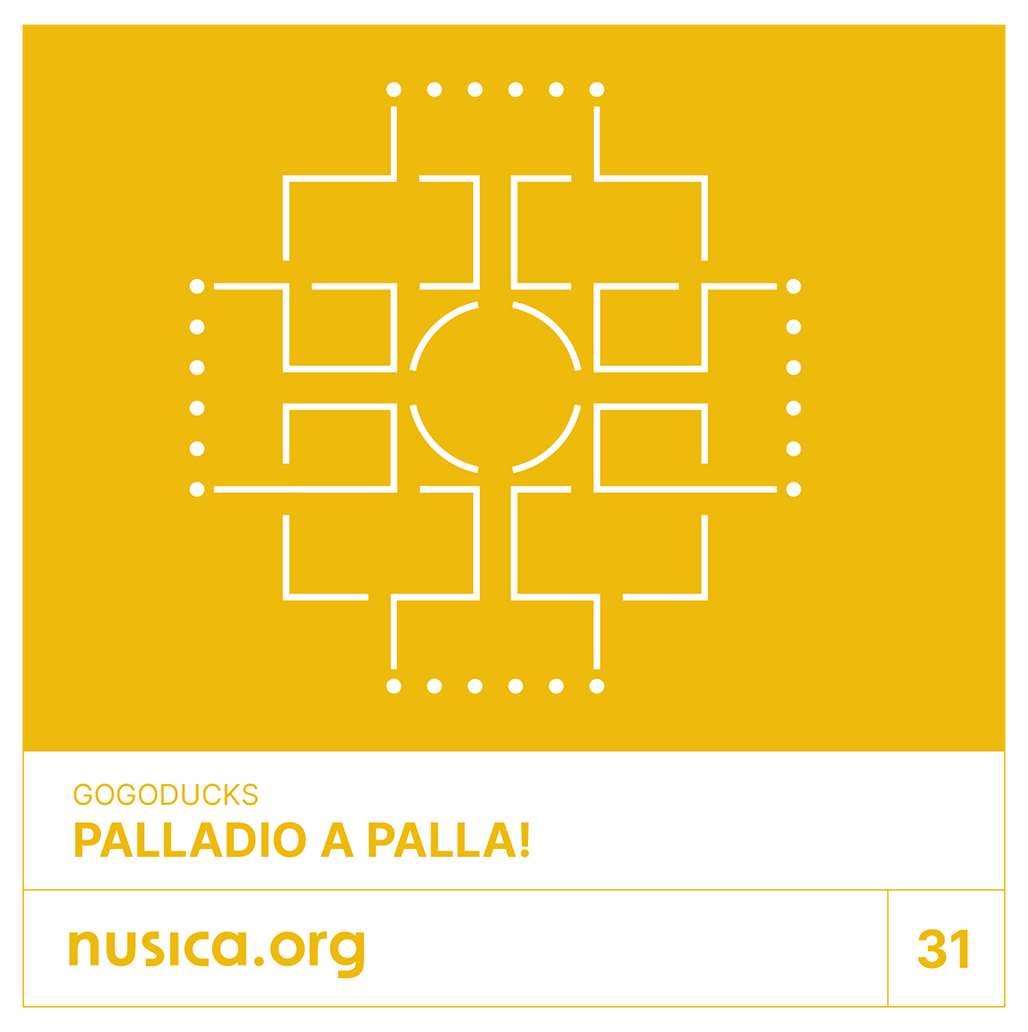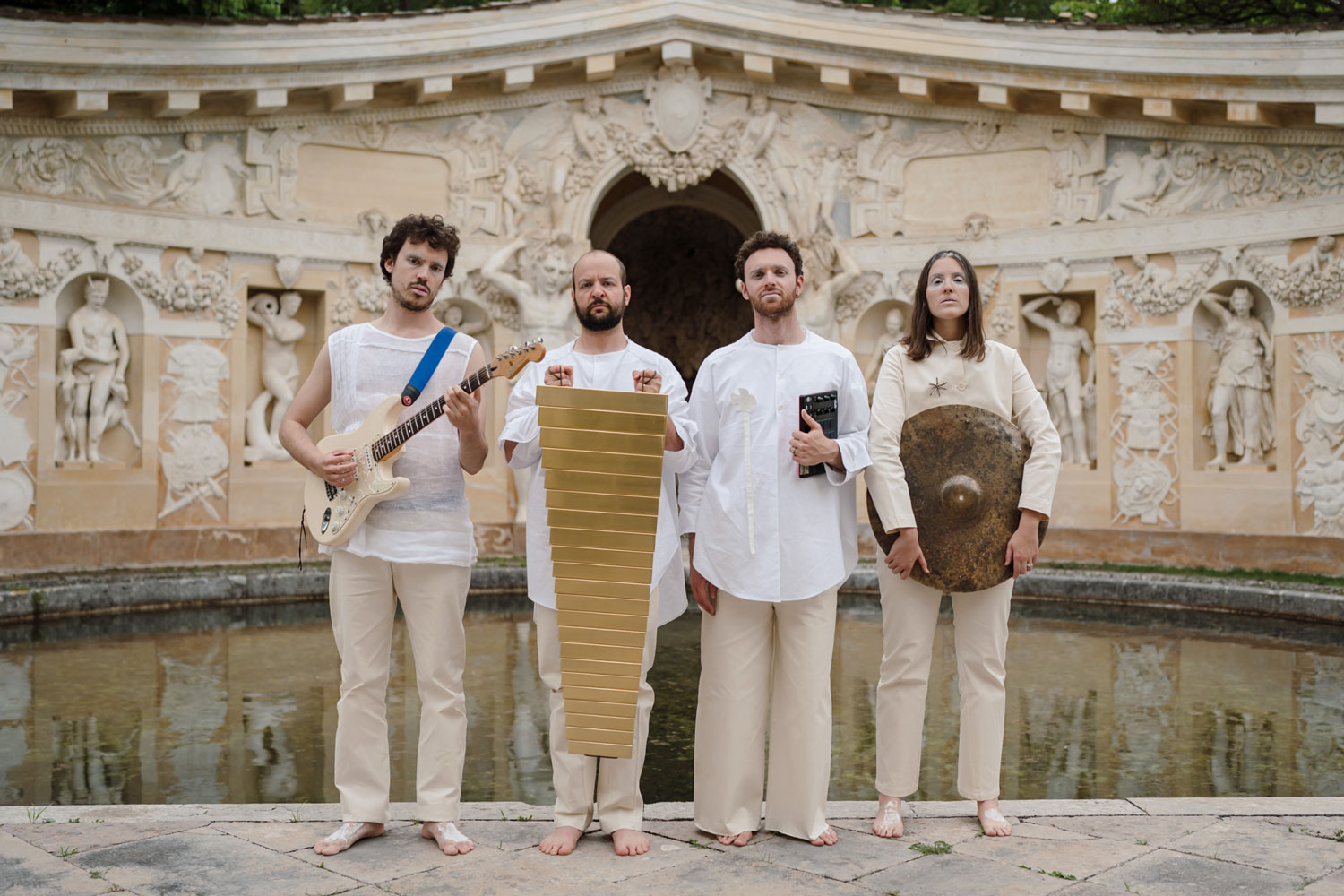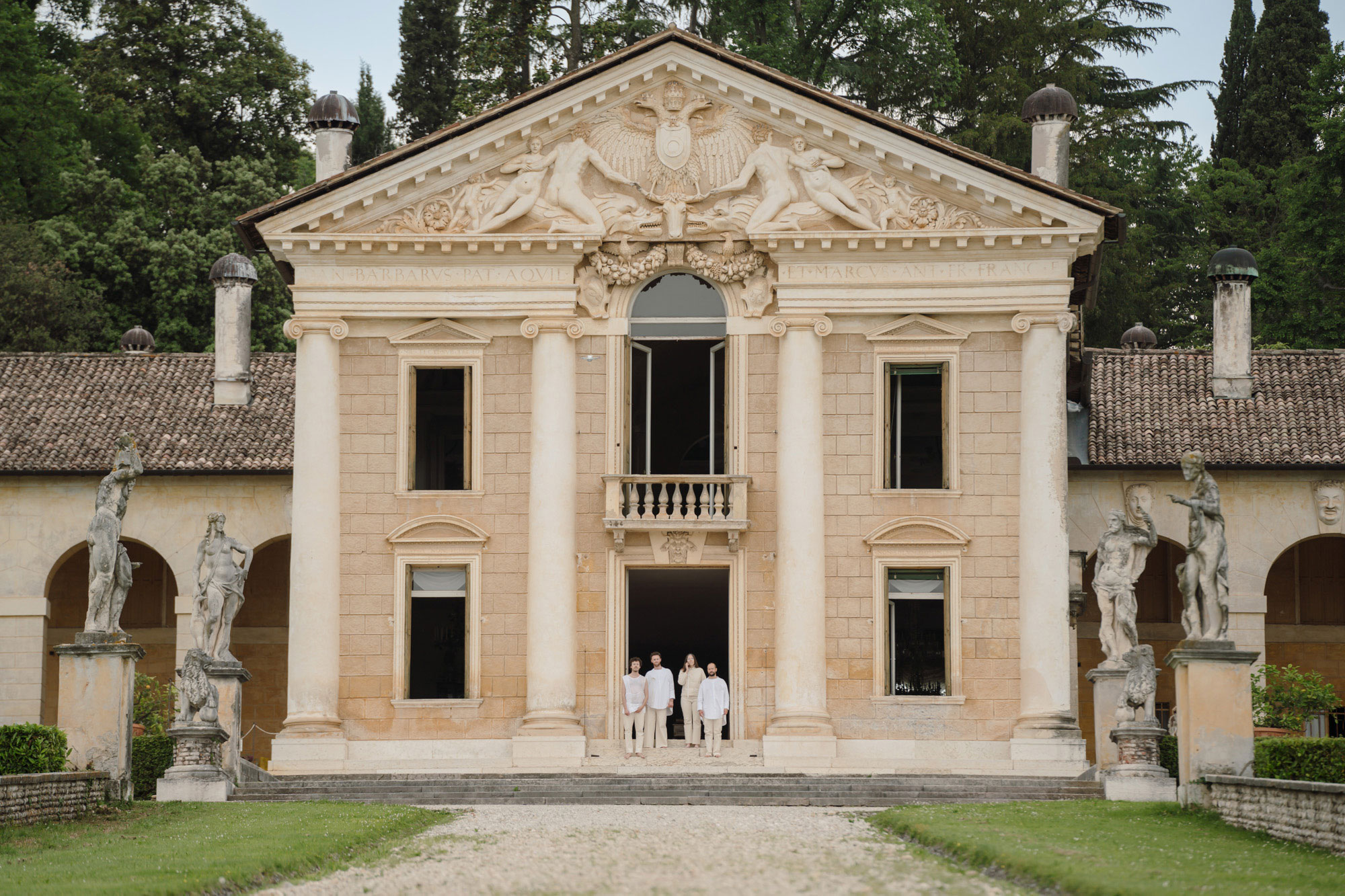31 – Palladio a Palla!
31 Palladio a Palla!
GOGODUCKS
With the support of MiC and SIAE, as part of the “Per Chi Crea” program
A tribute to one of the greatest artists in history.
A journey through the territory where he was born and worked, balancing between jazz, improvised music, architecture, and the digital universe.
The thirty-first production for nusica.org, a cultural association that promotes and supports innovative artists.
The new work by GOGODUCKS is set to be released on September 6, 2024.
The album is preceded by the release of the singles “Hang Arano” (July 26), “Broder” (August 9), and “At the Roundabout” (August 23).
The latest work by GOGODUCKS (Francesca Remigi, Luca Zennaro, and Paolo Peruzzi), set for release on September 6 by the nusica.org music label, moves between creativity and linearity. Winner of the SIAE “Per Chi Crea” competition, with the support of MiC, “Palladio a Palla!” is an album that, from its title, reveals the originality of its design, paying musical tribute to one of the most influential architects in history, the Venetian Andrea Palladio.
The project, inspired by nine of the sixteenth-century villas known as Palladian, attempts a virtuous synthesis between jazz, improvised music, architecture, and the digital universe.
Starting from the study of Palladio’s legacy, GOGODUCKS presents an album that pays tribute to his architecture, translating some of the compositional techniques used in his works into music: the well-defined use of rhythm, harmony, structure, energy, the relationships between elements, mathematical proportions, and the reinterpretation of tradition.
Their connection with the Veneto region, their homeland, leads GOGODUCKS to collaborate with Veronese creative coder Sergio Zacco for the creation of a video mapping inspired by the floor plans and architectural drawings, making the musical translation of Palladian architecture visible. Collaboration with Villa Angarano and Villa di Maser is also fundamental for the shooting of the video clip, a video interview, and some reels.
From this perspective, the compositional work carried out in the album aims to bring to life sound organisms that can be compared to Palladio’s forms, the ‘mechanisms’ of linearity and beauty in his actions, which often lead to contemplative immersion.
The nine tracks of “Palladio a Palla!” thus define a new geography, a mosaic of ironic and evocative tiles with titles based on wordplay, puns that reveal the innovative character of the project (“Better Ask Barbra,” “Sir Ego,” “At the Roundabout,” “Hang Arano,” “Poiena,” “E mò?,” “Broder,” “Corner,” “Malcontenta”) and show the strength of tradition, the perpetually contemporary nature of eternal beauty.
1. Malcontenta (04:06)
2. Hang Arano (06:32)
3. Broder (05:29)
4. At the roundabout (05:09)
5. Corner (03:31)
6. E mò? (04:00)
7. Poiena (05:38)
8. Better ask Barbra (03:26)
9. Sir Ego (05:36)
Francesca Remigi | batteria, percussioni
Luca Zennaro | chitarra, elettronica
Paolo Peruzzi | vibrafono e programmazione
Sergio Zacco | creative coding
Andrea di Pietro della Gondola | architettura
Registrato presso Artesuono Recording Studio
Registrato, mixato e masterizzato da Stefano Amerio
Prodotto da GOGODUCKS
Francesca Remigi, a versatile drummer, experimental composer, and innovative improviser, Francesca Remigi is an artist based in Milan. Winner of the Italia-Jazz Nuova Generazione Jazz 2021 contest and the Top Jazz 2022 (Musica Jazz) award as the best new Italian talent, Francesca is known for her numerous international collaborations in the field of Creative Music with musicians such as Steve Lehman, Danilo Perez, Dee Dee Bridgewater, Carmen Staaf, George Garzone, Joachim Florent, Kris Davis, Val Jeanty, Nicole Glover, Immanuel Wilkins, Marion Hayden, Ellen Rowe, Sharel Cassity, Bruno Chevillon, Yuhan Su, Alexander Hawkins, Tomeka Reid, Angelika Niescier, Antonello Salis, Gianluigi Trovesi, Camila Nebbia. Known for her participation in renowned international festivals including L’Off Jazz 2022, Melbourne International Jazz Festival 2022, EFG London Jazz Festival 2023, DC Jazz Festival 2021, Tashkent Jazz Festival 2024, Umbria Jazz Festival 2022, and Panama Jazz Festival 2022, Francesca is the winner of the SIAE Prize 2022, the Best Soloist award at the Getxo Jazz Competition 2022, and the first prize at the prestigious Keep an Eye International Award 2023. She is also a finalist for the Next Jazz Legacy Award 2023 and 2024 by New Music USA.
Luca Zennaro is a guitarist, composer, and bandleader born in Chioggia (Venice) in 1997. Over the past years, Luca has explored various musical territories: with his new EP “ZENMUSIC” he approaches electronic music in a project involving musicians like Chris Fishman, Giovanni Iacovella, Michelangelo Scandroglio, Francesco Panconesi, and PPIERRRRE. The originality of the group lies in its ability to navigate both electronic and acoustic music effortlessly. Luca is also the co-founder of Hackout!, a trio with which he has recorded two albums in two years and completed two European tours. Luca has collaborated with national and international musicians such as Benjamin Clementine, Francesco Bearzatti, Jacky Terrasson, Gabriele Mirabassi, Chris Fishman, Alessandro Lanzoni, and many others. In recent years, he has performed at festivals and clubs in Mexico, India, Israel, Denmark, Sweden, the UK, Senegal, Norway, Germany, the Netherlands, Belgium, Greece, Spain, Hungary, France, Austria, and Latvia. Luca is considered one of the most interesting musicians on the Italian jazz scene.
Paolo Peruzzi, in the words of NEA Jazz Master Terri Lyne Carrington, Paolo Peruzzi “is a musician with the curious and inquisitive nature to push the genre forward.” Kris Davis describes him as “extraordinarily talented, hardworking, curious.” Founder of the award-winning chamber percussion ensemble Palladrum in 2015, after graduating from the Pedrollo Conservatory in Vicenza, he went on to earn a performance diploma from the Berklee College of Music in Boston, USA. He was part of the Berklee Institute of Jazz and Gender Justice, whose mission is to support and promote a cultural transformation in jazz with gender justice and racial justice as guiding principles.
Sergio Zacco is a multimedia artist, creative coder, and musician. Graduating with honors in Electronic Music from the Vicenza Conservatory, he then pursued self-taught studies in creative programming, which is now his full-time occupation. Combining his artistic background with studies in new technologies, he designs and creates interactive installations and audio-visual content, in which various types of sensors allow the works to generate and modify themselves in real-time, based on the interaction of actors, musicians, or spectators.
Palladio a Palla!
Better ask Barbra
The reversal of traditional elements is the concept that gives life to this piece dedicated to Villa Barbaro. A jazz infused with the influences of Reich and Battiato, it builds continuous tension, while simultaneously offering a sense of liberation. This is a ballad that doesn’t invite dancing, but rather contemplation and listening. It’s like harmonic instruments supporting the melody of a rhythmic instrument. A piece that dips its toes into past experimentation, even though it’s not the weekend—but Wednesday.
Sir Ego
The arches of Villa Serego reflect a precise design, forming part of a larger, unexpected structure. Though simple—but never easy—it’s in the processes that the masterful creativity of a maestro is revealed, much like the recipe for a very complex dish. This piece has three main raw materials, different in nature, that mix, fuse, and combine through improvisation, echoing the mathematical elements always present in Palladio’s work in the form of a continuous circular movement tending towards irregularity. Seriality and architecture go hand in hand, with numbers creating the minimalistic foundation that stimulates initial improvisation and research.
At the roundabout
An imperfect round game outside a square. This piece is a tribute to Villa Capra, perhaps the villa that most evokes the architect Andrea Palladio. The circle of the dome, the soaring columns, the four sides with the four staircases, a continuous play of mirrors. Various elements inspired this piece, with its uncertain suggestions and incisive improvisations. Fundamental to the composition was the analysis of Palladio’s floor plans contained in “I quattro libri di architettura” (1570), where the architect lists La Rotonda among palaces (not villas). The fifth element is the context: extraordinary.
Hang Arano
The harmony in the forms of the facade of Villa Angarano results from the fusion of architectural elements representing multiples of the numbers 4, 3, 5, and 7. In this piece, the harmonic synergy of the villa’s geometric forms is rendered through a rhythmic technique called morphing, where the guitar gradually shifts over 4 measures from a triplet rhythmic pattern to a quintuplet pattern (always maintaining the same pitches), while the vibraphone does the same, moving from a 7:4 pattern to a 7-note riff in sixteenth-note subdivisions. The theme is repeated three times with different textures, inviting the listener into a contemplative trance of artistic beauty, proposing a cyclic structure that returns with ever-changing timbral details, generating wonder and curiosity.
Poiena
Inspired by Villa Poiana in the province of Vicenza, the piece “Poiena” is composed based on a numerical series that uses the distance between columns in the villa as the base unit of measurement. The composition is divided into three sections, introduced by free improvisation. It is structured around a bass line (section A) that, rhythmically and intervallically, follows the numerical sequence derived from the horizontal spatial scan of the columns. The chords in section B follow the numerical series representing the longitudinal grouping of columns. The coda describes the rhythmic-textural overlap of the elements of the villa’s facade.
E mò?
Dedicated to the majestic Villa Emo, “E mò?” is a piece constructed from a rhythmic-interval series derived from the grouping of the arches of the villa’s two lateral wings according to their planimetric subdivision corresponding to the various interior spaces. Sections B and C of the piece recall the rhythmic scan and proportions of some details of the roof, the facade, and the adjacent gardens of the villa.
Broder
“Broder,” inspired by Villa Badoer, takes as its model the Palladian neoclassical perfection, which in music is translated with open triads, moving symmetrically throughout the piece. The triads represent the three dimensions of Palladian architecture—height, length, and width.
Corner
For this piece, the alternation of the naves of Villa Cornero (3 and 4) was used as the time signature = 3/4. The piece switches to 5/4 in section B, as the number 5 also frequently appears in the villa’s geometries (5 arches, etc.).
Malcontenta
This Venetian villa features arches that become progressively smaller as you move inward. Therefore, I wrote a piece in which the melodic rhythm also becomes increasingly dense every 4 measures (4 measures like the main naves).
Sostieni nusica.org
nusica.org è un’associazione no profit che promuove la cultura musicale.
Partecipa al progetto con una donazione di 14 euro e riceverai il cd in regalo.




